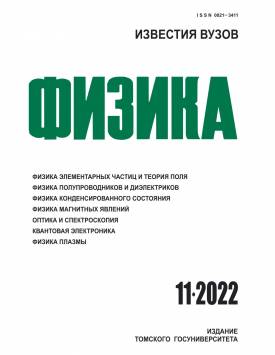Structure and properties of a high-entropy alloy subjected to saturation with boron by the additive method
Using the electron-ion-plasma additive method, the HEA film formed on a substrate (AISI 304 steel) was saturated with boron by vacuum deposition from gas-metal plasma created by simultaneous independent vacuum arc discharge evaporation of the cathodes of selected elements in the plasma-assisted mode. Doping of HEAs with boron and oxygen atoms, as well as with substrate atoms has been revealed. It is shown that the multicycle modification of the HEA film is accompanied by the formation of a nanostructured multiphase layer with a thickness of 5-7 µm, containing inclusions of borides and oxides of the HEA chemical elements and the substrate. It has been established that the modification of the HEA film leads to a multiple (by 18 times) decrease in the wear parameter of the material.
Keywords
borides,
vacuum arc discharge plasma-assisted method,
multy-cycle processing,
deposition,
phase composition,
structure,
microhardness,
wear resistanceAuthors
| Ivanov Yu.F. | Institute of High Current Electronics of SB RAS | yufi55@mail.ru |
| Shugurov V.V. | Institute of High Current Electronics of SB RAS | shugurov@opee.hcei.tsc.ru |
| Petrikova E.A. | Institute of High Current Electronics of SB RAS | elizmarkova@yahoo.com |
| Prokopenko N.A. | Institute of High Current Electronics of SB RAS | nick08_phantom@mail.ru |
| Teresov A.D. | Institute of High Current Electronics of SB RAS | tad514@sibmail.com |
| Tolkachev O.S. | Institute of High Current Electronics of SB RAS | ole.ts@mail.ru |
Всего: 6
References
Cantor B., Chang I.T.H., Knight P., Vincent A.J.B. // Mater. Sci. Eng. A. - 2004. - V. 375-377. - P. 213-218.
Yeh J.W. // Adv. Eng. Mater. - 2004. - V. 6. - P. 299-303.
Pickering E.J., Jones N.G. // Int. Mater. Rev. - 2016. - V. 61. - No. 3. - Р. 183-202.
Huahai Mao, Hai-Lin Chen, Qing Chen //j. Phase Equilib. Diffus. - 2017. - V. 38. - Р. 353-368.
Ye Y.F., Wang Q., Lu J., et al. // Mater. Today. - 2016. - V. 19. - P. 349. - DOI: 10.1016/j.mattod.2015.11.026.
Gromov V.E., Konovalov S.V., Ivanov Yu.F., Osintsev K.A. Structure and Properties of High-Entropy Alloys. - Switzerland: Springer Nature, 2021. - 110 p.
Miracle D.B., Senkov O.N. // Acta Mater. - 2017. - V. 122. - P. 448-511. - DOI: 10.1016/j.actamat.2016.08.081.
Praveen S., Kim H.S. // Adv. Eng. Mater. - 2018. - V. 20. - P. 1700645. - DOI: 10.1002/adem.201700645.
Lai Ch.-H., Lin S.-J., Yen L.-W., Chang Sh.-Y. // Surf. Coat. Technol. - 2006. - V. 201. - No. 6. - P. 3275-3280.
Рогачев А.С. // ФММ. - 2020. - Т. 121. - № 8. - С. 807-841.
Günen A. // Surf. Coat. Technol. - 2021. - V. 421. - P. 127426. - DOI: 10.1016/j.surfcoat.2021.127426.
Erdogan A., Günen A., Gok M.S., Zeytin S. // Vacuum. - 2021. - V. 183. - P. 109820. - DOI: 10.1016/j.vacuum.2020.109820.
Storr B., Moore L., Chakrabarty K., et al. // APL Mater. - 2022. - V. 10. - P. 061109. - DOI: 10.1063/5.0098276.
Liu D., Zhao J., Li Y., et al. // Appl. Sci. - 2020. - V. 10. - P. 49. - DOI: 10.3390/app10010049.
Nakajo H., Nishimoto A. //j. Manuf. Mater. Process. - 2022. - V. 6. - P. 29. - DOI: 10.3390/jmmp6020029.
Prokopenko N.A., Petrikova E.A., Shugurov V.V., et al. // IOP Conf. Ser.: Mater. Sci. Eng. - 2021. - V. 1093. - P. 012025. - DOI: 10.1088/1757-899X/1093/1/012025.
Devyatkov V., Ivanov Yu., Krysina O., et al. // Vacuum. - 2017. - V. 143. - P. 464. - DOI: 10.1016/J.VACUUM.2017.04.016.
Ivanov Yu.F., Krysina O.V., Petrikova E.A., et al. // High Temp. Mater. Process. - 2017. - V. 21(1). - P. 53. - DOI: 10.1615/HIGHTEMPMATPROC.2017021265.
